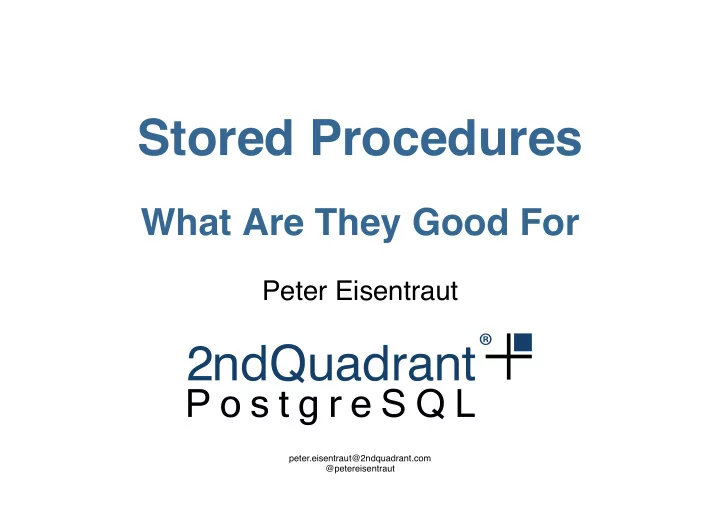

Stored Procedures What Are They Good For Peter Eisentraut peter.eisentraut@2ndquadrant.com @petereisentraut
CREATE PROCEDURE new_customer(name text, address text) LANGUAGE plpgsql AS $$ BEGIN INSERT INTO customers VALUES (name, address); END $$; CALL new_customer('somename', 'someaddress');
CREATE PROCEDURE convert_to_upper(INOUT string text) LANGUAGE plpgsql AS $$ BEGIN string := upper(string); END $$; CALL convert_to_upper('abc'); string -------- ABC (1 row)
CREATE PROCEDURE new_customer(name text, address text) LANGUAGE plperl AS $$ $plan = spi_prepare('INSERT INTO customers VALUES ($1, $2)'); spi_exec_prepare($plan, $_[0], $_[1]); $$; CALL new_customer('somename', 'someaddress');
CREATE PROCEDURE transaction_test1(x int, y text) LANGUAGE plpgsql AS $$ BEGIN FOR i IN 0..x LOOP INSERT INTO test1 (a, b) VALUES (i, y); IF i % 2 = 0 THEN COMMIT; ELSE ROLLBACK; END IF; END LOOP; END $$; CALL transaction_test1(9, 37);
CREATE PROCEDURE transaction_test1() LANGUAGE plperl AS $$ foreach my $i (0..9) { spi_exec_query("INSERT INTO test1 (a) VALUES ($i)"); if ($i % 2 == 0) { spi_commit(); } else { spi_rollback(); } } $$;
CREATE PROCEDURE transaction_test1() LANGUAGE plr AS $$ for(i in 0:9){ pg.spi.exec(paste("INSERT INTO test1 (a) VALUES (", i, ")")) if (i %% 2 == 0) { pg.spi.commit() } else { pg.spi.rollback() } } $$; https://github.com/petere/plr/tree/procedure-transaction
DO LANGUAGE plpgsql $$ BEGIN FOR i IN 0..9 LOOP INSERT INTO test1 (a) VALUES (i); IF i % 2 = 0 THEN COMMIT; ELSE ROLLBACK; END IF; END LOOP; END $$;
CREATE PROCEDURE transaction_test2() LANGUAGE plpgsql AS $$ DECLARE r RECORD; BEGIN FOR r IN SELECT * FROM test2 ORDER BY x LOOP INSERT INTO test1 (a) VALUES (r.x); COMMIT; END LOOP; END; $$;
CREATE PROCEDURE p1() LANGUAGE plpgsql AS $$ BEGIN CALL p2(); END $$; CREATE PROCEDURE p2() LANGUAGE plpgsql AS $$ BEGIN CALL transaction_test1(9, 37); END $$; CALL p1(); CREATE PROCEDURE p1() LANGUAGE plpgsql AS $$ BEGIN SELECT f2(); END $$; CREATE FUNCTION f2() LANGUAGE plpgsql AS $$ BEGIN CALL transaction_test1(9, 37); END $$; CALL p1();
(non)atomic execution context
top-level ☞ non-atomic ⬇ ⬇ CALL p1 ☞ non-atomic ⬇ ⬇ CALL p2 ☞ non-atomic ⬇ ⬇ CALL transaction_test1 ☞ non-atomic COMMIT -- OK ✅
top-level ☞ non-atomic ⬇ ⬇ CALL p1 ☞ non-atomic � ⬇ SELECT f2 ☞ atomic ⬇ ⬇ CALL transaction_test1 ☞ atomic COMMIT -- error ❌
other stuff that disallows transaction control transaction block GUC settings attached to procedure security definer cursor loop not read-only inside subtransaction (block with exception handling)
other stuff that doesn't work (yet) procedures with OUT parameters VACUUM etc. inside procedures support in other PLs
use cases porting (Oracle, DB2) batch stuff audit logging
CREATE PROCEDURE batch_geocode() LANGUAGE plpgsql AS $$ BEGIN WHILE EXISTS (SELECT 1 FROM addr_to_geocode WHERE pt IS NULL) LOOP WITH a AS (SELECT addid, address FROM addr_to_geocode WHERE pt IS NULL ORDER BY addid LIMIT 5 FOR UPDATE SKIP LOCKED) UPDATE addr_to_geocode SET pt = ST_SetSRID(g.geomout, 4326)::geography FROM (SELECT addid, (gc).rating, (gc).addy, (gc).geomout FROM a LEFT JOIN LATERAL geocode(address, 1) AS gc ON (true) ) AS g WHERE g.addid = addr_to_geocode.addid; COMMIT; END LOOP; END; $$; http://www.postgresonline.com/journal/index.php?/archives/390-Using-procedures-for-batch-geocoding-and-other- batch-processing.html
CREATE PROCEDURE new_customer(name text, address text) LANGUAGE plpgsql AS $$ BEGIN INSERT INTO audit_log (entry) VALUES ('someone tried to create a new customer'); COMMIT; INSERT INTO customers VALUES (name, address); END; $$; CALL new_customer('somename', 'someaddress');
CREATE PROCEDURE waste_xid(cnt int) LANGUAGE plpgsql AS $$ DECLARE i int; BEGIN FOR i IN 1..cnt LOOP PERFORM txid_current(); COMMIT; END LOOP; END; $$;
implementation details
SPI functions SPI_connect_ext(SPI_OPT_NONATOMIC) SPI_start_transaction() SPI_commit() SPI_rollback()
tips for PL authors write a giant test suite use SPI_connect_ext() implement commit/rollback calls use portal pinning ( PinPortal() , HoldPinnedPortals() ) use PortalContext instead of TopTransactionContext consider lifetime of objects carefully
dynamic result sets (not implemented) CREATE PROCEDURE pdrstest1() LANGUAGE SQL AS $$ DECLARE c1 CURSOR WITH RETURN FOR SELECT * FROM cp_test2; DECLARE c2 CURSOR WITH RETURN FOR SELECT * FROM cp_test3; $$; CALL pdrstest1();
the end
Recommend
More recommend